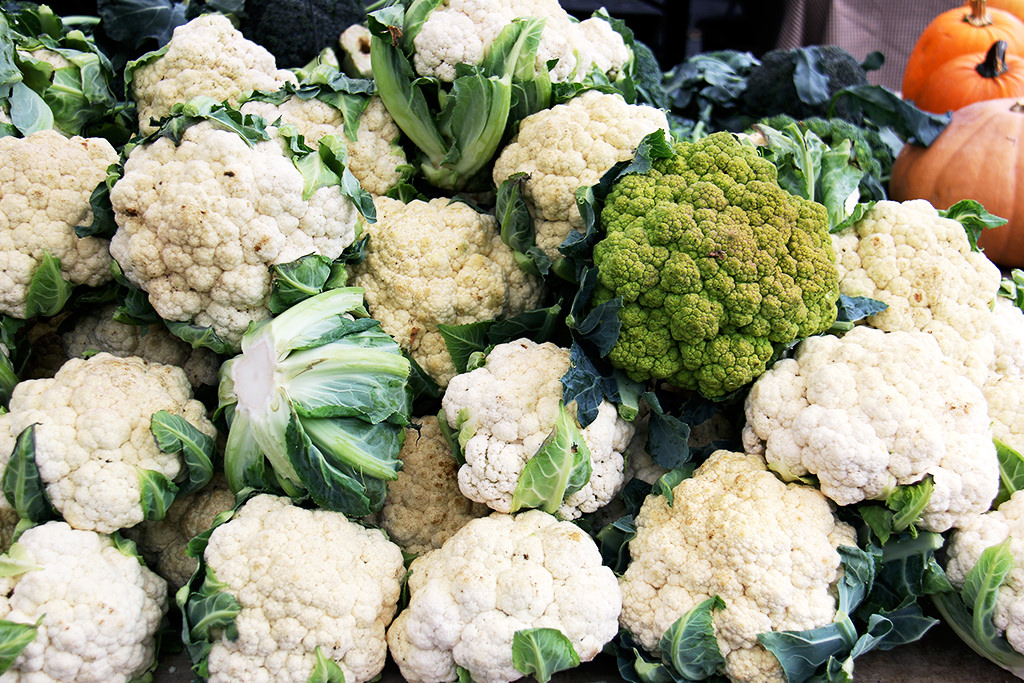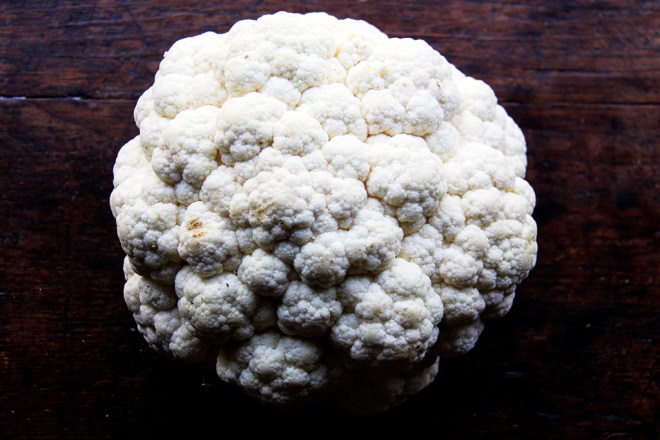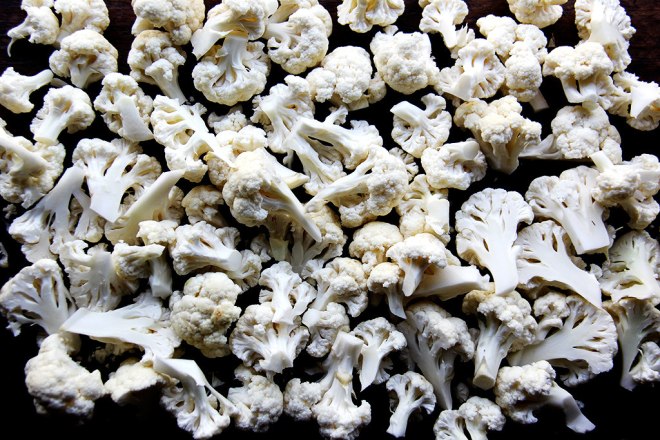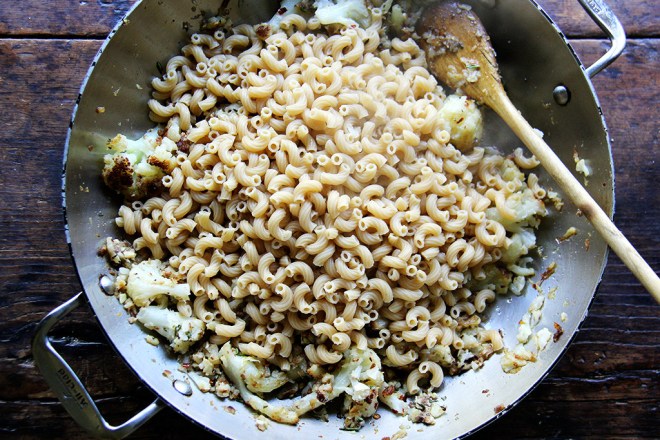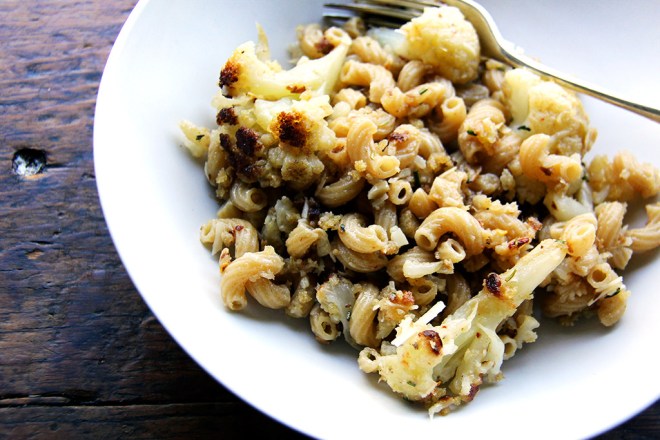Winter is coming and we’re serious about keeping farmers market produce on the menu. Alexandra Stafford of Alexandra Cooks is showing us how to store, prep, and make the most of the bounty, without wasting a scrap. This recipe will teach you the ways.
In a food world where al dente, crisp, and caramelized reign, pasta tossed with long-cooked, falling-to-pieces cauliflower might not ever catch on. Add to it breadcrumbs and cheese, and the monochromatic sight might send a nutritionist on a plate-as-color-wheel rant.
But if you can get beyond the texture and the color, this dish, which comes from Pasta: Recipes from The Kitchen of the American Academy in Rome, might make you forget crispy edges altogether — or at least make you appreciate the beauty of tender cauliflower melting into a sauce. In the book, this recipe falls in the vegetable-based sauces chapter, which puts the long cooking time into perspective: The cauliflower florets, after a five-minute blanching and 20-minute sauté, become the sauce, the teensy pieces disintegrating altogether, the bigger stalks, which could be spread like butter, remaining intact. During the lengthy cooking, the cauliflower sweetens before meeting a salty anchovy-garlic paste and a heavy pinch of red pepper flakes, a trinity of seasonings rooted in Roman cooking.
If you’re worried you’ll crave more contrast in texture, don’t — toasted breadcrumbs sprinkled at the very end provide the nicest crunch. And if you can’t get over the spectrum of pale colors, try a whole-grain pasta: Farro, kamut, buckwheat, and spelt pastas, with their nutty, earthy flavors, pair especially well with the boldness of this sauce.
Cauliflower, too, cannot only handle assertive flavors, but can also be a bit of a chameleon, capable of dramatic changes in nature depending on its preparation. When roasted at high heat, it becomes crisp and caramelized, a preparation that might lead you to eat a whole head in a single sitting. When boiled and puréed, it becomes velvety smooth, the creamiest cream-less soup imaginable, a boon for vegans and omnivores alike. When poached then roasted whole or cut into slabs and pan-seared like a steak, it becomes meaty, an all-star of Meatless Mondays.
But cauliflower can be prepared simply, too, especially when it’s fresh. I had never boiled cauliflower before making this pasta recipe, always favoring roasting at high heat, guilty of wanting those crispy, caramelized edges. But boiled cauliflower cooked in heavily salted water emerges tasting buttery and creamy on its own. And though it barely needs a drizzle of anything, I’ve been loving dressing the poached florets with a few tablespoons of brown butter, sprinkling them with tarragon, and showering them with crispy breadcrumbs, a preparation for which I have Chez Panisse Vegetables to thank. Crispy and colorful, it’s a dream for gourmands and nutritionists alike.
To store your cauliflower:
- Cauliflower is a member of the cruciferous family (broccoli, cabbage, kale, brussels sprouts, etc.) and comes in a variety of colors including white, gold, pale green, and purple. Look for firm, compact heads with fine-grained curds. If possible, avoid heads with brown spots or any discoloration, but small brown spots are fine — just cut them off. Store cauliflower in the vegetable bin of your fridge for a week or longer. If you can fit it in a bag, do so, otherwise wrap with a tea towel. Cauliflower that has been cut into florets should be used within a day or two.
To prep your cauliflower:
- Remove outer green leaves and stems and, if you are feeling especially nose-to-tailish, reserve these greens and cook (steam, sauté, etc.) them alongside the cauliflower. If the recipe specifies cutting the head into florets, use a paring knife to remove the stems from the center stalk. The stalk can be cut up and cooked as well.
To cook your cauliflower:
- Cauliflower pairs well with assertive flavors: garlic, anchovies, red pepper flakes, olives, capers, saffron, paprika, curry powder, and turmeric. As noted above, it’s versatile and can be cooked in so many ways.
- Cauliflower can be eaten raw or briefly blanched and served with aioli or bagna cauda. When shredded, raw cauliflower makes a great slaw.
- Fresh cauliflower needs little doctoring. It can be blanched in heavily salted water for five minutes and tossed with a little butter or olive oil. Dress this preparation up with brown butter, herbs, and crispy breadcrumbs.
- Cauliflower can be roasted whole, in slabs or in florets:
Whole: After a 20-minute poaching in a flavorful broth, a whole head of cauliflower can be roasted until brown all over, then served with a tangy, whipped goat cheese sauce.
Slabs: Cut a head of cauliflower into one-inch thick slices, then pan-sear them and finish them in the oven until tender.
Florets: Season with olive oil, salt, and pepper, spread onto sheet pan, and roast at 425 degrees F until tender, about 30 minutes. To dress these florets up, toss them with any number of seasonings before roasting or toss them with herbs and breadcrumbs after roasting.
Cauliflower can be boiled, mixed with water and sautéed onions, and puréed into the smoothest, creamiest vegan soup. For a richer preparation, simmer the cauliflower in milk with garlic and purée it with butter and herbs.
Cauliflower can be simmered with milk or broth or water, puréed until smooth, and used as a filling for ravioli, as a spread for crostini, or as a lightened-up bechamel. Cauliflower’s flavor pairs nicely with fruits such as apple or pears — simmer the florets and the peeled, diced fruit together, then purée them until smooth. Use as a purée or thin into a soup.
Cauliflower can be added to curries and stews or braised in flavorful broths, like one with wine, olive oil, onions, and olives.
Pan-roast or sauté cauliflower florets in a skillet with olive oil until browned and tender. Add pine nuts, breadcrumbs, herbs, and currants for a simple but impressive side dish. Or toss the browned florets with pasta, walnuts, and ricotta salata. Or bake them into a frittata.
Cauliflower can be blanched and mixed with flour and eggs and seasonings and fried into fritters or pancakes. It can be baked into pastas and gratins. It, like everything, can be pickled.
Pasta with Slow-Cooked Cauliflower, Anchovies, and Garlic
See the full recipe (and save it and print it) here.
Serves 4
1 whole cauliflower, about 2 pounds before being trimmed
4 to 5 tablespoons olive oil
1 to 2 cloves garlic, depending on your preferences
4 to 5 anchovy fillets
Minced fresh rosemary to taste, optional (a little goes a long way)
1/2 teaspoon crushed red pepper flakes, or more or less to taste
1/2 pound pasta, whole-wheat varieties are nice here, and small shapes (orecchiette, elbows, etc.) are nice, too
1/2 cup toasted breadcrumbs
1/2 cup grated Grana Padano or Parmigiano Reggiano

